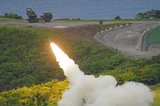US carrier visits Hong Kong amid heightened China tensions
An American warship and carrier strike group visited Hong Kong on 21 November in a move seen as a conciliatory gesture by China ahead of next week's crunch meeting between the global superpowers' presidents.
The port call at the semi-autonomous city comes just two months after China nixed a similar visit by the US Navy, and at a time of heightened tensions between Washington and Beijing, fuelled by a burgeoning trade war.
The aircraft carrier USS Ronald Reagan arrived in Hong Kong waters with two destroyers, the USS Benfold and USS Curtis Wilbur, and guided-missile cruiser USS Chancellorsville.
Tension is simmering between China and the US, who have this year traded punishing tariffs on billions of dollars' worth of imports.
The two crossed swords at last week's APEC summit over the rules of global trade, with the group of 21 nations failing to issue a joint statement for the first time.
US President Donald Trump and his Chinese counterpart Xi Jinping are set to meet at the G20 summit in Argentina which starts on 30 November.
'It is a friendly gesture made by the Chinese side to let the USS Ronald Reagan visit Hong Kong before the scheduled meeting between President Xi and President Trump in Argentina,' Beijing-based military expert Zhou Chenming told the South China Morning Post.
Prior to the Navy's arrival, senior People's Liberation Army commander Lt Gen Tan Benhong and other officers were invited to visit the USS Ronald Reagan on the deck as it sailed to Hong Kong, the newspaper reported.
In September, China cancelled a scheduled visit by a US warship to Hong Kong and scrapped plans for a meeting between the head of the Chinese navy and his American counterpart.
The moves came around the time US B-52 bombers flew through international airspace over the South China Sea and the East China Sea.
In 2016, China denied US aircraft carrier USS Stennis and accompanying naval vessels permission to make a port call in Hong Kong amid heightened tensions between the two countries over Beijing's moves to assert its claims to much of the South China Sea.
More from Defence Notes
-
![Taiwan approved for purchase of $11 billion in weapons from US]()
Taiwan approved for purchase of $11 billion in weapons from US
The US State Department’s approval of a multi-billion-dollar sale of weapons to Taiwan includes tactical mission networks equipment, uncrewed aerial systems, artillery rocket systems and self-propelled howitzers as well as anti-tank guided missiles.
-
![US National Security Strategy prioritises advanced military capabilities and national industry]()
US National Security Strategy prioritises advanced military capabilities and national industry
The 2025 NSS has emphasised investment in the US nuclear and air defence inventory and national industry, but it leaves multiple unanswered questions on how the White House will implement this approach.
-
![Canada set to look away from its neighbour and across the Atlantic for partners]()
Canada set to look away from its neighbour and across the Atlantic for partners
While non-EU UK struggles to join the Security Action for Europe initiative, which provides loans for defence programmes, Canada has become the first country outside Europe to get access – and did so for a nominal fee.
-
![NATO experiments with solutions to integrate networks, AI and uncrewed systems]()
NATO experiments with solutions to integrate networks, AI and uncrewed systems
During the latest edition of the NATO DiBaX, the alliance tested multiple capabilities to inform requirements for future efforts.
























